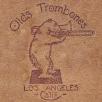
It's a bear!
S-24G Super and P-24G Custom Bass Trombones
Bore: .565" (14.4 mm), .585" (14.9 mm) attachment
Bell:
S-24G: 9½" (241.3 mm)
P-24G: 9" (228.6 mm)
Olds built the first double-valve bass trombone in the late 1930's. Over the next three decades, that same basic design remained in production, eventually becoming the S-23 Super Bb-F-E bass trombone. By the late 1960's, what had been an innovative design achieved a degree of obsolescence approaching anachronism. Compared to other bass trombones of the era (both doubles and singles), it was significantly undersize - almost more an extra-large tenor than a true bass trombone. A change was definitely in order.
At the same time, Olds was having great success with their S-22 George Roberts model single-rotor bass. Much more modern in design, and helped along by the cachet of Roberts' name, it sold very well; even today, GR model basses are always in demand. The obvious move for Olds would be to design a double based on the S-22.
The new horn could easily have ended up being just an S-22 with a second valve grafted into the the f-attachment, but Olds decided to try something new. Technican/customizer George Strucel had recently introduced the idea of a bass trombone with an inline (or independent) double-rotor system (possibly inspired by the independent systems that had been used on some contrabass trombones at least as early as the 1930's). Rather than placing the second valve in the f-attachment tubing (where it could only be used when the f-attachment was engaged), he put it in the neckpipe, right next to the first valve. He also gave the second valve a separate, finger-actuated lever in place of the side-by-side thumb levers used on earlier designs.
Olds placed the new horn in their "Super" line and gave it the model number S-24G, the "G" being derived from the tuning of the second valve (G). It was the first factory-produced independent double rotor bass - and it had problems. Olds bass trombone rotors had always been on the small side, and putting two of them in the open horn resulted in a very stuffy blow. Additionally, the lever for the second valve tended to bump the player's collar bone when the paddle was depressed. The undersize valves remained for the S-24G's production run, but Olds did attempted to address the lever issue by installing a bracket under the valves to make sure there was sufficient clearance for the lever, but some players found the bracket itself uncomfortable (note the horn shown here came to me without a bracket, though it appears to have had one at one time).
With such obvious shortcomings, the S-24G was doomed. Olds went back to the drawing board, reworking not only the S-24G, but the S-22, as well. Larger valves and new linkages were obviously top priority, but they also increased the spacing between the neckpipe and the bell tail, necessitating a wider tuning slide. The new horns were placed in Olds' new "Custom" line and given the model designations P-22 (for the single) and P-24G (for the double); the P-22 also carrying the "George Roberts" name. Both models sold well, and remained in the Olds line until the very end. The P-24G was in the Olds line at least as early as 1976, as evidenced by the copyright date on this introductory pamphlet that was furnished with the instrument..
Both are mostly nickel silver with red/rose brass bells. The P-24G shown here is the early version, with a finger hook under the mouthpiece receiver and "flat stock" valve levers of solid nickel silver. Later P-24G's lack the finger hook and have "round stock" valve levers made of plated brass.
I've chosen to show the horns side-by-side to make it easier to compare them. Except as noted in the captions, the S-24G is on the left, the P-24G is on the right.
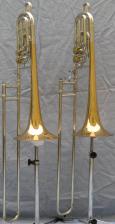 Overall view |
 Engraving S-24G |
 Engraving P-24G |
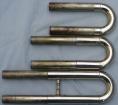 Second Valve Crooks (All P-24G) G flat G /1 Gb |
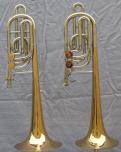 Bells - Front |
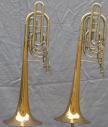 Bells - Back/2 |
||
 End Crooks |
 Main Tuning Slides |
 Cork Barrels |
 Slides P-24G on top |
| Notes: | |
| /1 | The flat G crook is a custom alteration of an original Gb crook; the work was done for me by Bruce Belo. |
| /2 | This image shows the quickest way to distinguish between an S-22 or S-24G and a P-22 or P-24G. Note how much more space there is on the P-24G between the attachment tubes where they attach to the valves. Also note that on the S-24G, the diameter of the valve casing is the same as that of the stop plate; the P-24G has the same size stop plates, but the valve casings are noticeably larger in diameter. |